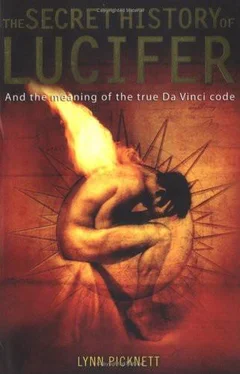(The identification of snakes with evil is so ingrained that a serpent, tongue flickering horribly, simply had to be the symbol for Hogwarts' house of Slytherin, alma mater of all magicians who went to the bad, in J.K. Rowling's Harry Potter novels. Yet Harry's unconscious skills do set a boa constrictor free from London Zoo, who is polite enough to hiss 'Thanks', before slithering off.)
The unedifying story of the expulsion from Paradise is believed to be essentially about the arrival of sin among humankind - its fall from grace and future as the plaything of evil and the repository for all known pain and suffering. While the preferred modern view is to dismiss it as nonsense or at best see it as an allegory, a surprising number of Christians still believe that Adam and Eve literally existed and that we have since suffered from their sin.
However, perhaps the story is most revealing about God's own nature. He appears to be as much at a loss with Adam and Eve as they are in their new circumstances - and not much of a psychologist, despite having created the prototype man and woman in the first place. Did he really believe that banning a certain substance, the fruit of a tree - that one over there, look! - would mean that they would obediently steer clear of it? Clearly he has a great deal to learn as a father.
Not only does God seem taken aback by the whole episode, but also he seems neither to have understood that he has created intellectual curiosity and a desire for sensuous satisfaction nor that the snake, too, was his handiwork, saddled with a set of characteristics that inevitably led him to tempt the woman. Like Judas in his role as catalyst for Jesus' sacrifice, the snake was doomed from the first. And both are seen as literal embodiments of, or at best, servants of evil. And - after Eve's calamitous fall - traditionally women have been seen as not much better.
Perhaps, too, the myth also contains an element common in modern science fiction, the fear of the robots' rebellion. Just as medieval and Renaissance Jewish legends told of the horror of the golem, a magically animated man, in the story of the Fall God's robotic creatures seize the initiative, revealing an inherent - and potentially dangerous - intelligence that their creator did not want to acknowledge. The creation myth is famously parodied in Mary Shelley's Frankenstein, although perhaps it may be less of a travesty and closer to the original than is usually thought.
However, although it might seem a pointless exercise to question or read such a modem interpretation into what is essentially a group of ancient myths, even today's most sharply sophisticated cultures are still heavily influenced by them and their potent ramifications. Even in the twenty-first century, much of the JudaeoChristian legacy informs the way that even most materialist sceptic thinks and behaves. Whether we like it or not, that legacy has built the history that spawned us, and shaped the attitudes that linger, often unpleasantly, in the dark recesses of our minds.
Perhaps, though, God did have a psychological understanding of Eve, knowing she would inevitably fall prey to the serpent. Perhaps the whole episode of the Fall was set up to test the loyalty of the first man and woman. But, in that case, surely their banishment was somewhat harsh? Perhaps a stiff talking-to, literally to put the fear of God into them, and another chance to prove themselves, would have made more sense? It is only too easy to liken God's reaction to that of a spoilt child taking out his spite on his new toys, the rather mindless Adam and Eve, when they failed to work according to the instructions. Indeed, if he had never experienced any other being standing up to him, a spoilt child is pretty much what he would have become. But was he ever challenged - apart from Adam and Eve in what was to prove their critical act of rebellion?
According to the Old Testament, Yahweh was confronted by one of his own leading angels, Lucifer, in a sort of explosive palace coup - which, of course, failed spectacularly, ending with the rebel leader's banishment to Earth, and beyond, into the nightmarish realms of hell.
To the Jews, the infernal regions were ablaze with Gehenna, a river of fire, although the name was often applied to the whole area. The concept of Hell as a fiery pit, so beloved of medieval theologians and witch-hunters, actually originated in ancient Egyptian wall paintings of `the wicked' being consumed by fire, although in fact these tormented souls were not meant to represent human sinners, but elemental spirits, enemies of the sun god Atum.31 However, that religion never laid any emphasis on eternal punishment for sin, the afterlife being instead a sort of assault course of monsters and demons that could be overcome with the right spells.
Although Egyptians spent their entire lives, and often their fortunes, trying to escape death - which they called `an abomination' - an essential aspect of their belief was that the dying-andrising god Osiris had saved humanity from death through the process of rebirth.
But in the West, the concept of Hell has long proved useful to keep the vulnerable in terror of God. Although this subject will be discussed in detail later, the following extract from the nineteenth century Father Furniss' Sight of Hell, an improving tract for young people, will suffice to convey these sadistic fantasies:
Of two little maids of sixteen, one cared only for dress, and went to a dancing school, and dared to disport in the park on Sunday instead of going to mass: the little maid stands now, and forever will stand, with bare feet upon a red-hot floor. The other walked through the streets at nights and did very wicked things; now she utters shrieks of agony in a burning oven. A very severe torment - immersion up to the neck in a boiling kettle - agitates a boy who kept bad company, and was too idle to go to mass, and a drunkard; avenging flames now issue from his ears. For like indecencies, the blood of a girl, who went to the theatre, boils in her veins; you can hear it boil, and her marrow is seething in her bones and her brain bubbles in her head. `Think,' says the compassionate father, `what a headache that girl must have!'32
Surely no comment is necessary.
As we shall see in a later chapter, some of the worst excesses of hellish punishments were invented by patriarchal societies to terrorize women. Barbara Walker notes, for example, that in this male-dominated Hell:
Women who scolded would be forced to lick hot stoves with their tongues. Women who showed disloyalty to men would be hung up by one leg, while scorpions, snakes, ants and worms dug their way in and out of their bodies 33
`Disloyalty to men' is a conveniently loose term open to a wide variety of interpretations.
We are not told whether Hell existed before the war in Heaven, but it certainly existed afterwards, when Lucifer lost his heavenly status. Isaiah apparently describes this landmark event:
How art thou fallen from heaven O day-star, son of the morning! (Helel ben Shahar) How art thou cast down to the ground, That didst cast lots over the nations!
And saidst in thy heart: `I will ascend into heaven, Above the stars of God (El) Will I exalt my throne; And I will sit upon the mount of meeting, In the uttermost parts of the north; I will ascend above the heights of the clouds; I will be like the Most High (Elyon).' Yet thou shalt be brought down to the nether-world, To the uttermost parts of the pit.3a
While the putative existence of this once-great, but apparently anonymous, hero of Heaven provides the opposing force to God's goodness - and to a cynic an excuse for the evils of the world - in fact the passage quoted above may well simply be an allusion to a Phoenician or Canaanite myth about Helel, son of the god Shaher, who, coveting the almighty god's throne, was cast down into the abyss. But while in northern Syria there is an ancient poem about Shaher (dawn) and Shalim (dusk) - two divine offspring of the god El - no mention is made in the Canaanite sources of a Lucifer figure or a revolt against God.
Читать дальше












